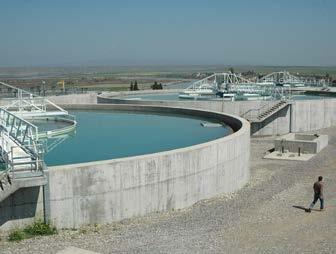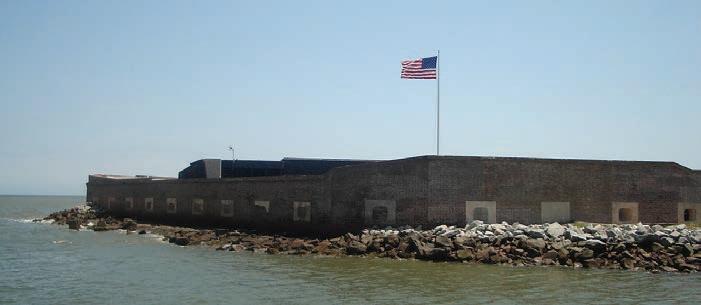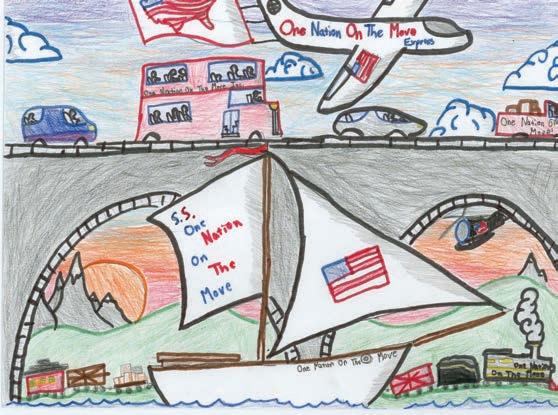
6 minute read
Cumulative Reconstruction Snapshot
Aparade of vintage vehicles was the pivot point to this year’s NTW celebration, “One Nation on the Move,” held in Detroit, Michigan, on Mother’s Day. Families lined the streets to catch a glimpse of a convoy of golden oldies, such as the 1932 Ford Deuce, roll on by. One participant, for sure, did not go by unnoticed—an 18-wheeler sporting 1st Place prize-winning artwork from the hand of Thomas Dolan (see previous page). In total, three YRC Worldwide brands (Roadway, Yellow and USF Holland) supplied trucks, trailers, drivers, and eye-catching graphics that put Thomas’ poster “on the move” along the cruise route.
In addition to participating in the Detroit parade, YRC Worldwide trucks were stationed as decorative backdrops to other NTW venues around town including the landmark Henry Ford Museum in Dearborn Village, Michigan. One Nation on the Move—One Poster on the Move
“The 48-foot trailer is an excellent format for getting attention,” explained Denny Edwards, Marketing Vice President for the NDTA, who introduced the concept of NTW trailer art to YRC Worldwide back in 2003. “The commanding size is captivating whether stationary or moving. The poster itself is easy for kids to relate to since it was created by one of their peers, albeit in the ‘far-away’ state of Pennsylvania.”
YRC Worldwide is in this for the “long haul.” The company became involved in National Transportation Week in 2000, when they joined fellow NDTA corporate members as NTW Founding Benefactors to help launch a series of events commemorating transportation and industry professionals. One of the objectives is to expand transportation awareness to future transporters through schools and public attractions spotlighted during the week-long celebrations. Who knows . . . this special appearance in Detroit may have inspired some young parade-watchers to join the future team of professionals that will keep our “Nation on the Move.” DTJ
Gulf Region Division, US Army Corps of Engineers
CUMULATIVE RECONSTRUCTION SNAPSHOT By Command Information, Gulf Region Division, US Army Corps of Engineers
Reconstruction efforts are a vital component to Iraq’s progress toward democracy.
>> NDTA recognition of National Transportation Week goes well beyond our borders even though events commemorate stateside modes and achievements. Let’s not forget the terrific progress in infrastructure that has taken place in Iraq thanks to the Corps of Engineers. We appreciate the update from the field and we send you our best!
Despite 25 years of neglect and a costly insurgency, Iraq’s infrastructure is bouncing back, and US assistance projects are having a real impact on the lives of its people, rebuilding Iraq’s infrastructure, supporting the emergence of democracy, and establishing a foundation for a strong economy.
US efforts were intended to jumpstart reconstruction efforts. The success of reconstruction is dependent on Iraqi funding, donor nation support, and security. It will take time and considerable resources to rebuild Iraq after years of neglect under Saddam’s rule. US funds are only a part of the overall broader effort, which will be continued with Iraq’s own enormous human and capital resources and the support of other donor nations.

Statistics below reflect GRD portion of projects funded under Iraq Relief and Reconstruction Fund (IRRF), Developmental Fund of Iraq (DFI), Commander’s Emergency Response Fund (CERP), Economic Support Fund (ESF), and Iraq security Forces Fund (ISFF).

(Note: Data compiled by contractor Stanley Baker Hill from the Iraq Reconstruction Management System (IRMS) database of construction projects in Iraq. Data are being pulled from the GRD Bench Mark table in IRMS. Data subject to change as more project information is entered. This does not include non-construction investments such as equipment purchases, training, and some security. Cumulative data compiled up to April 30, 2007.)
At transfer of sovereignty in June 2004, there were just 200 projects started. As of April 30, 2007, USACE/GRD has:
• 4271 planned projects; construction cost of $8.07 billion; program cost of $8.84 billion • 3280 completed projects; construction cost of $4.25 billion; program cost of $4.39 billion • 681 ongoing projects; construction cost of $3.28 billion; program cost of $3.28 billion • 227 projects awarded yet to be started
ELECTRICITY • Of 2023 megawatts planned, 1420 megawatts have been added and restored, increasing the capacity of electrical power to serve 1.3 million households (6.5 million Iraqis or 20 percent of the population). • 561 planned, 353 projects completed with 139 ongoing. • Strengthened and stabilized the electrical transmission grid through the completion of 21 132/400kV substations and six overhead line projects affecting 425,000 households and 2.1 million Iraqi citizens. • Completed construction of 89 33/11kV substations affecting 825,000 homes (4.5 million people or 17 percent of the Iraqi population). • Employed an average of 7000 Iraqi citizens per week.
OIL • 110 projects planned, 67 completed, 19 ongoing. • Of 3.0 million barrels per day of planned capacity, current oil production capacity is at 2.8 million barrels per day. • Oil production increased immediately following the war by 1.9 million barrels per day, generating added revenue to the Iraqi economy. • Natural gas production capacity increased post-war by 300 million standard cubic feet per day. • Liquefied petroleum gas production capacity increased post war by 2000 tons per day. • Employed approximately 5000 Iraqi citizens per week.
WATER • 861 planned, 581 completed, 198 ongoing. • Of those, 583 are water treatment and sewage projects with 413 completed and 138 ongoing. • Of the 1.1 million cubic meters per day of potable water planned, 463,000 cubic meters per day of water treatment capacity have been achieved. • Provides potable water capacity to approximately 2.5 million Iraqi people (8 percent of population). • With the 673,000 cubic meters per day of water treatment capacity that is under construction, an additional 2.7 million Iraqi people will be affected for a total 5.2 million (20 percent of the Iraq population). • Employed an average of 1600 Iraqi citizens per week.
FACILITIES • 2739 planned, 2279 completed, 325 ongoing.
TRANSPORTATION AND COMMUNICATION • Completed 318 kilometers of village roads. An additional 109 kilometers of village road projects are ongoing. • 98 railroad renovation projects at 96 railroad stations have been completed, which accounts for 93 percent of total railroad stations. • 14 of 19 aviation projects are completed, affecting 3 airports and 4000 passengers per day. • Completed 6 port projects, increasing port support for 50 ships per day. This accounts for 60 percent of the port capacity in Iraq. • Employed an average of 2300 Iraqi citizens per week.
BUILDING, HEALTH, AND EDUCATION • 166 Primary Healthcare Centers—128 Primary Healthcare Centers are under construction with 38 complete and 9 impacted by insurgent activities. • Of the 47 hospital renovation projects planned, 10 are ongoing with 30 completed at 20 hospitals across the country. • This increases the capacity to treat about 3.25 million patients annually in hospitals and 630,000 outpatients annually at the PHCs, which is 14 percent of the patient population. • Renovation or construction of 986

schools is complete, improving quality learning environments for more than 500,000 kindergarten through 8th grade students (9 percent of the total amount of students/schools in Iraq). • Employed an average of 2650 Iraqi citizens per week.
SECURITY AND JUSTICE • Completed construction on 152 border forts and 10 Point of Entry facilities (includes MNSTC-I projects). • Completed renovation on 91 fire stations, which makes up 30 percent of the total number of fire stations or firefighting services for Iraq. • Completed work on 31 courthouses with 7 ongoing. • Constructing/rehabilitating four correctional facilities that will provide 4090 beds and improving conditions for 1700 more. This will increase new beds by 43 percent and improve 18 percent of existing bed space. • Employed an average of 3500 Iraqi citizens per week. DTJ






